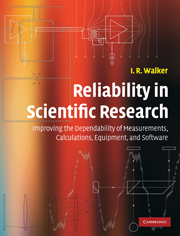 Reliability in Scientific Research
Reliability in Scientific Research Book contents
- Frontmatter
- Contents
- Preface
- List of abbreviations
- 1 Basic principles of reliability, human error, and other general issues
- 2 Mathematical calculations
- 3 Basic issues concerning hardware systems
- 4 Obtaining items from commercial sources
- 5 General points regarding the design and construction of apparatus
- 6 Vacuum-system leaks and related problems
- 7 Vacuum pumps and gauges, and other vacuum-system concerns
- 8 Mechanical devices and systems
- 9 Cryogenic systems
- 10 Visible and near-visible optics
- 11 Electronic systems
- 12 Interconnecting, wiring, and cabling for electronics
- 13 Computer hardware and software, and stored information
- 14 Experimental method
- Index
- References
6 - Vacuum-system leaks and related problems
Published online by Cambridge University Press: 05 June 2012
- Frontmatter
- Contents
- Preface
- List of abbreviations
- 1 Basic principles of reliability, human error, and other general issues
- 2 Mathematical calculations
- 3 Basic issues concerning hardware systems
- 4 Obtaining items from commercial sources
- 5 General points regarding the design and construction of apparatus
- 6 Vacuum-system leaks and related problems
- 7 Vacuum pumps and gauges, and other vacuum-system concerns
- 8 Mechanical devices and systems
- 9 Cryogenic systems
- 10 Visible and near-visible optics
- 11 Electronic systems
- 12 Interconnecting, wiring, and cabling for electronics
- 13 Computer hardware and software, and stored information
- 14 Experimental method
- Index
- References
Summary
Introduction
Leaks in vacuum systems are an age-old and common problem in scientific research. Although they are nuisances in many situations, leaks are generally most troublesome when they appear in ultrahigh vacuum (UHV) systems and cryogenic apparatus. In both cases, even minuscule leaks, which are difficult to detect and can be intermittent, may be sufficient to disable the equipment. The thermal stresses on both types of equipment can cause cracks to form in the vacuum envelopes and joints that can lead to leaks. Turn-around periods for these systems can be very long. In the case of UHV devices, bakeout of the vacuum chambers is usually required, which may take a day or more. In order to use cryogenic apparatus, one must usually cool down and warm up the equipment very slowly. Time scales for this range from about an hour to a day or more, depending on the type of equipment. Hence, the leak testing of these systems can be very time-consuming and nerve-wracking.
In the case of cryogenic systems in particular, the relative fragility of the equipment, and the presence of large thermal and mechanical stresses during the routine operation and handling of these devices, promotes the formation of leaks. In these systems, leaks may occur only when the apparatus is cold, and therefore often inaccessible to direct investigation.
- Type
- Chapter
- Information
- Reliability in Scientific ResearchImproving the Dependability of Measurements, Calculations, Equipment, and Software, pp. 138 - 189Publisher: Cambridge University PressPrint publication year: 2011


